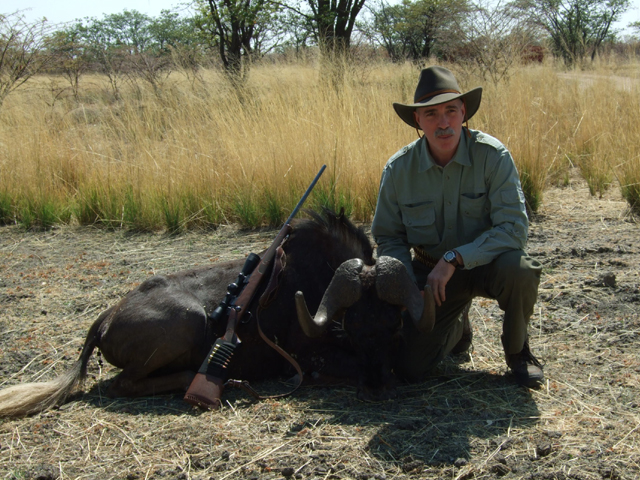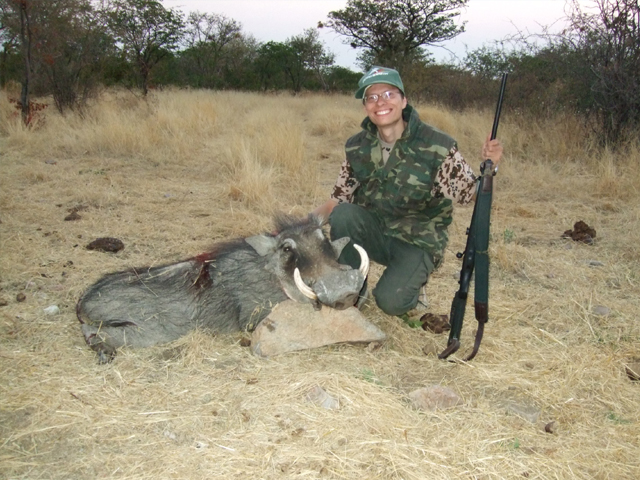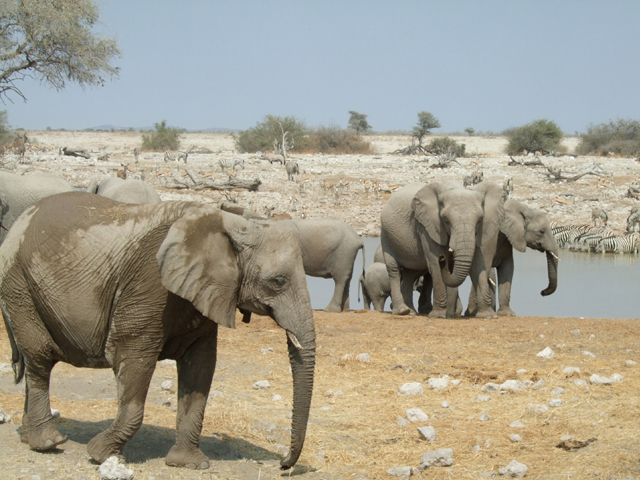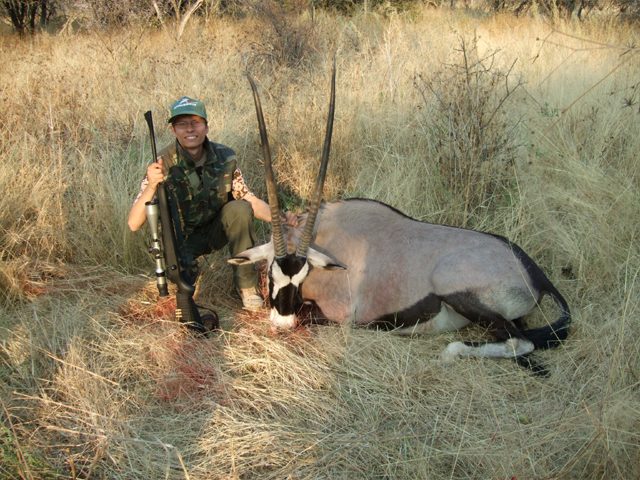Plainsgame hunting in Namibia
First experiences with the black continent
Many think in Africa about war, crime, poaching and unstable conditions, which is supported in particular by the reports on TV. What is often overlooked is that Africa also has very stable regions and indescribable biodiversity of wild and plant species as well as diverse landscapes. I felt the same way when, for the first time, I decided to take a hunting trip to Africa. Ultimately, however, I was positively surprised, but more on that later. After much deliberation, the decision was made to make my first trip to Namibia, the former German South West Africa. Namibia itself is one of the most stable countries in Africa, with a very good security policy.
The day of the departure was uncomplicated. Air Namibia is used to transport hunters with weapons, so that the baggage handling was very fast and smooth. With still a little queasy feeling in the belly we flew then approx. 10 hours directly from Frankfurt to Windhoek. Already when leaving the plane but the original concerns, a friendly reception at the passport control, as well as an uncomplicated handover of the weapon, after a one-page document filled with passport and weapon data, made the reservations forgotten and the anticipation of the upcoming hunt outweighed. Before the 5 hour drive to the farm in the north booth a visit from Windhoek on the agenda. Here is still clearly the German past visible, not only the street names and many of the shops with German inscription, also the widespread German language with whites but also with many blacks made you feel at home quickly and at a Windhoek warehouse or one of the German beers can initiate the upcoming hunt.
The drive to the farm over mostly well-developed roads gave already a first impression of the landscape of Namibia. It passed by huge termite mounds, thorn bushes and cattle ranches. In the landscape PuTTY Agent , flat plains alternated with mountainous regions. From time to time, warthogs or baboons crossed the lane. From our driver we learned that especially in the evening and in the morning changing Kudu antelope, cause many serious and often fatal accidents, which also explains why here on the signs of wildlife mostly kudu are depicted.
After about 5h drive from Windhoek over Otjiwarongo and Outjo we reached the hunting farm Hillendale. The warm welcome by Johann and his wife Imka, both German speaking, followed the reference of the Chalais, which are equipped as 2 or 4 bed chalais with private shower. In the evening, the events of the day were exchanged at the campfire with the returning hunters of another hunting group, and the next day was already discussed. Until late into the night stories were told from the bush, with clear differences between the 4 German and the 3 American hunters were visible. Our American friends had precise ideas of how many inches their next kudu should have, whereas for us German hunters were the experience and a mature old trophy in the foreground.
The hunt begins
Day 1 of the hunt started very early in the morning so that you can start the game drive after a sumptuous breakfast if possible before or at sunrise. Depending on the planned hunting area, this can be directly on the Farm Hillendale, which is a pure hunting farm, or on one of the adjacent cattle ranches belonging to the 400,000ha conservancy. We started on the actual hunting farm with the goal of kudu or springbok. Here, this always ran on the same principle. First known places are approached, then these are stalked on foot. During the trip we saw large herds of Elands, Wildebeest, Blesbok and young Kudus. However, the old kudu we searched for did not appear at first. As neither springboks nor suitable kudu were visible during the ride my PH decided to go on foot in the afternoon more purposefully on foot, with success. After 1h stalking through the glistening sun and spiked bush landscape we saw brown-white blankets flashing in the undergrowth, springboks! Quickly the decision was made and with consideration of the wind the herd was turned over and slowly creeping we approached the desired goal. 20 minutes later we slowly got into position. The Springbok herd was a little further, but still in good shooting distance. When we looked at it, we saw that it was a female herd with two young and one head buck, this was the right age. Crouching on knees, resting on the PH’s shoulder, the target spike hit the springbok’s blade and the shot broke, causing the springbok to collapse in the fire. My first African game was. The joy is huge and true to our tradition also got the springbok in the African bush his last bite and I from my PH my break. It was already getting dark so we loaded the Springbok as fast as possible on the pickup and successfully drove back to the main camp, where we were already expected by our other hunting colleagues.

The next day we wanted to look for our hunting luck on a somewhat more remote cattle farm, on these not wild-furred fenced farms, the game can move freely and lives in intimate unity with the cattle. Our focus on the day was the oryx. Already at the entrance to the farm, we were welcomed by larger groups of this widespread wild species. However, these were initially young bull groups, so we decided to stalk one of the many smaller mountains in order to see the area from the top. During the ascent we were suspiciously watched over by baboons and the rare Klipspringers. At the summit we had a breathtaking view over the plain and saw more groups of oryx, including a group of bulls and cows. This was our attention now and we began the laborious descent in the direction of the spotted Oryx group. 150 meters in altitude and 20 minutes later we were back in the plane and stalked tree by tree through the sand, towards the oryx, which were now slowly pulled to a water hole. Thanks to the good wind we reached the Oryx group at 150m and decided to go down for an old Oryx cow. Carefully, the tripod is posted, the shot breaks and hits the Oryx directly into the chamber, as Oryx, however, are very firing hard goes the shot Oryx cow despite chamber shot with the 8x68s still 30m before she goes down with the heart shot in the high grass. After the obligatory photo, the Oryx is loaded and we drive back to the mission station with school, where 100 children are already eagerly waiting for the meat donated to this mission. During the evening sitting by the fire, we learned that our American hunters, each with a wildebeest and our German colleagues with waterbuck and kudu, were also successful.

The next three days were alternately hunted on the main farm and adjacent cattle farms and water holes. Here I could kill a boar and a Blesbock. Especially in the African winter (July-September) are the Ansitze at the waterholes very promising, since the grass is dry for the most part and thus especially the warthog very often come to the water points.
Touristikprogram – The Etosha National Park
The trip ended with a visit to the famous Etosha National Park in northern Namibia. The park offers a wide variety of Namibian and African wildlife, including antelope species such as springbok, oryx and kudu, as well as lions and elephants, which are easily seen from the car and observation platforms. This park is a unique experience not only for us hunters but also especially for our non-hunting escorts, as you get very close to the game in large herd.

After 7 days of Namibia with interesting hunting experiences and an impressive visit to the Etosha National Park, we head back to Germany. This first visit to the African continent left a lasting impression on me and will certainly not be the last. The most important finding is that Africa undoubtedly has problems, but countries like Namibia in particular are very safe and stable, providing us hunters with an interesting alternative to hunts in Europe.
